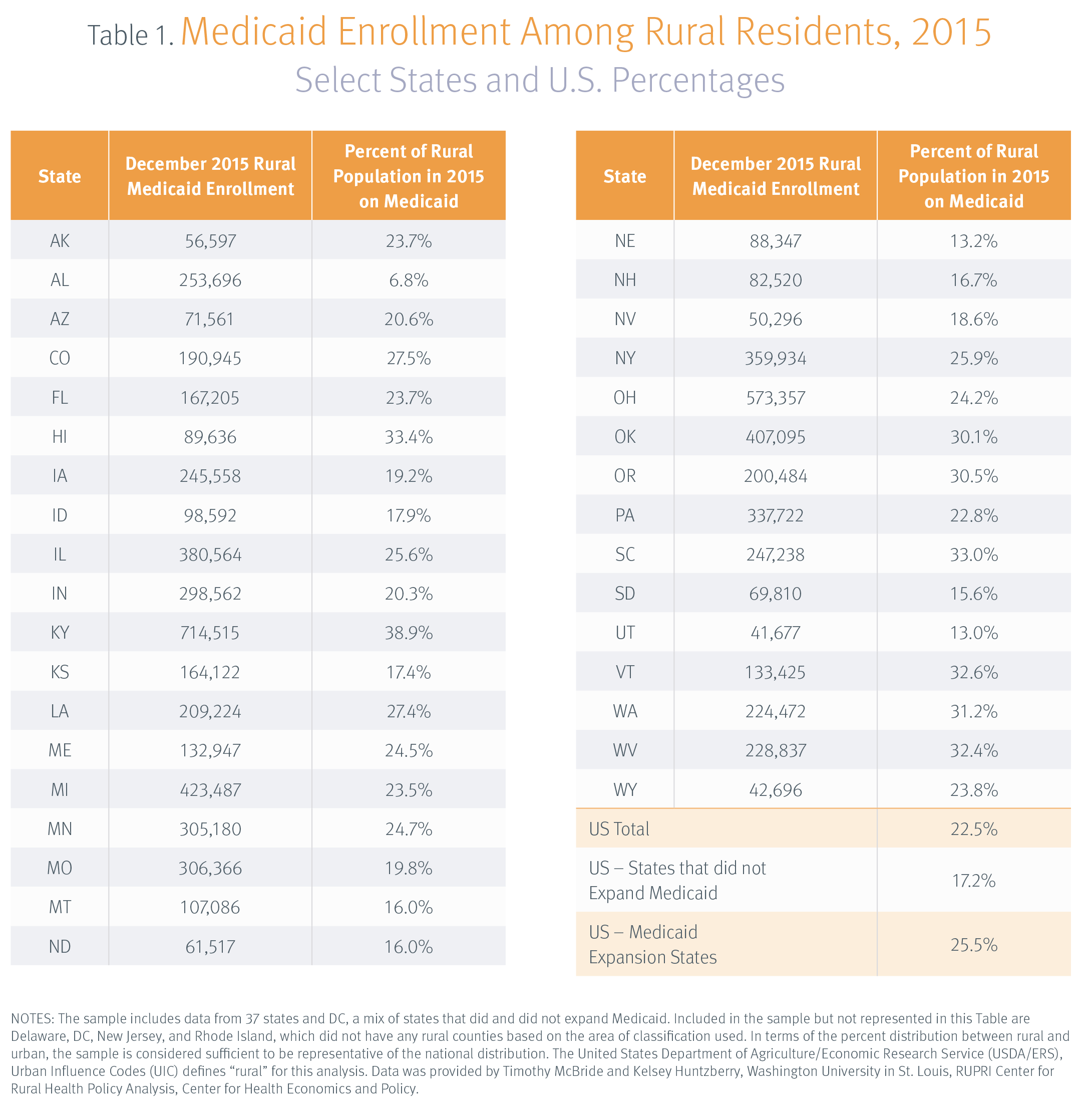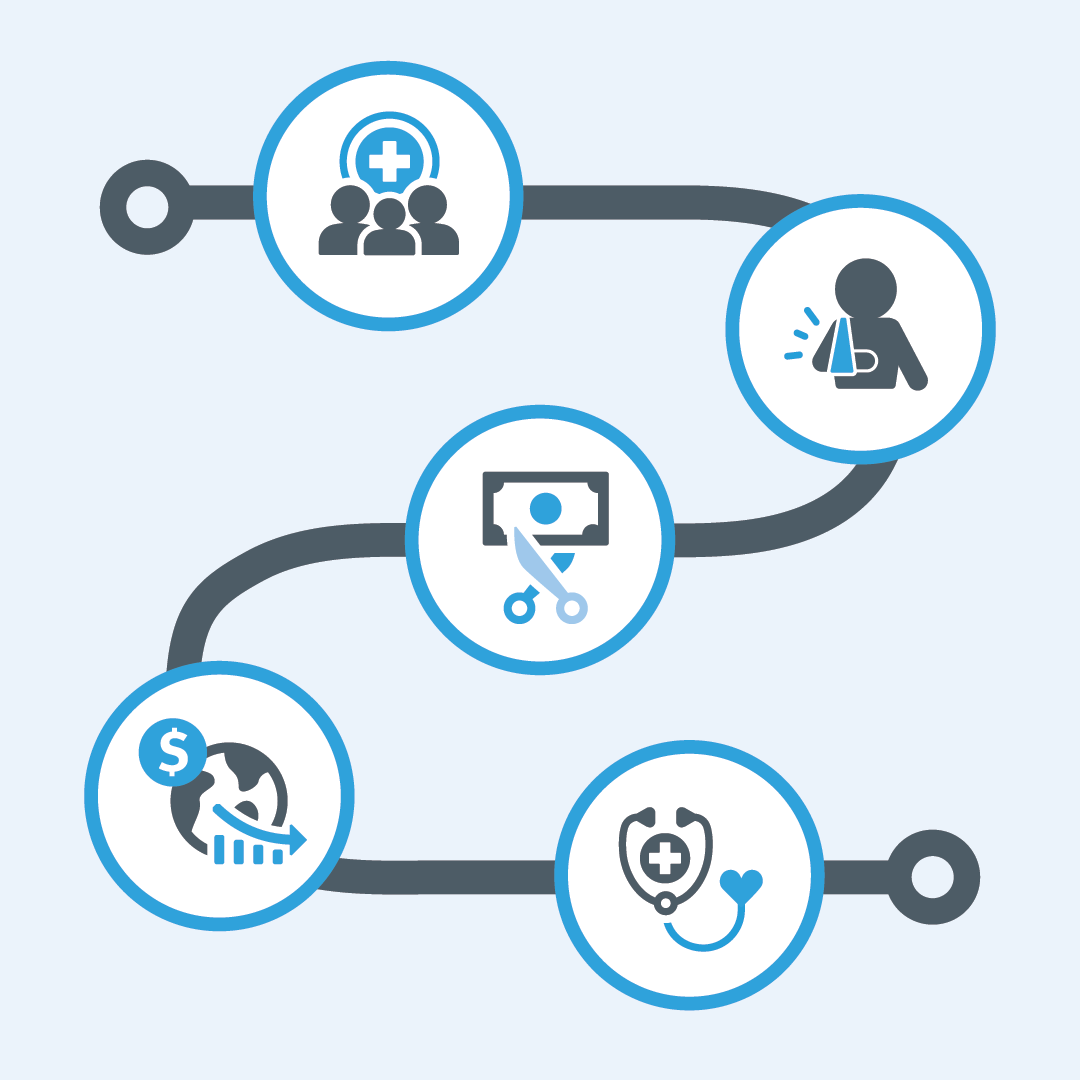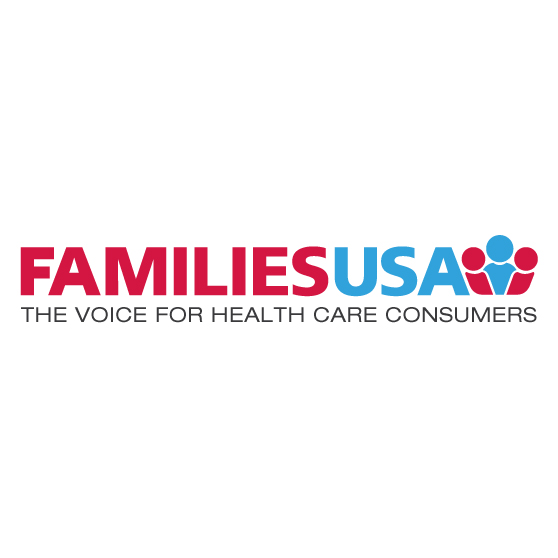Cutting Medicaid Would Hurt Rural America
03.23.2017
Medicaid is critical to the fabric of rural America.
Rural residents in communities across America rely on Medicaid to get health coverage. Medicaid also helps rural hospitals keep their doors open so they can continue to provide people with health care and jobs.
If Republicans in Congress end the Affordable Care Act’s (ACA) Medicaid expansion or radically change the structure of the Medicaid program by capping and cutting funding, it could severely hurt rural Americans and cripple state economies across the country.
Rural residents rely on Medicaid
22.5 percent of rural residents rely on Medicaid for health care coverage. In states that have expanded Medicaid under the ACA, that number increases to more than 25 percent. (See Table 1)
People in rural areas are more likely to depend on Medicaid than their urban counterparts. In rural areas, people are less likely to have higher incomes or jobs that include health insurance, and the population tends to be older with higher incidences of disability.1
Who are some of the rural residents counting on Medicaid for health coverage?
- Children: 47 percent of rural children get their health coverage through Medicaid.2
- Veterans: 5.3 million veterans live in rural America and 41 percent of them struggle with service-related disabilities.3 Many of these veterans and their family members rely on Medicaid, particularly the Medicaid expansion, for their health coverage.4
- Seniors and people with disabilities: Nearly one-third of dual eligibles—low-income seniors and people with disabilities who rely on both Medicare and Medicaid—live in rural areas.5 They rely on Medicaid to pay for home care, nursing home care, and other critical health care needs that Medicare does not pay for.
- Low-wage workers: Workers in rural areas tend to make less and are less likely than urban workers to get health insurance through their employer.6 As a result, Medicaid—and particularly the Medicaid expansion—is an important source of health coverage for rural workers.7
Cutting Medicaid—ending the Medicaid expansion or capping and cutting payments—would put the health care of millions of rural Americans at risk.
Rural communities depend on Medicaid.
With a large percent of rural residents relying on Medicaid, a strong Medicaid program is critical to the health of rural health systems and rural economies.
- Rural hospitals are critical to rural communities, and Medicaid is critical to those hospitals. Rural hospitals serve as essential sources of care and essential employers. In rural areas, hospitals often account for as much as 20 percent of local economies.8 Yet many rural hospitals are at financial risk—80 hospitals have closed since 2010.9 Medicaid accounts for nearly 15 percent of rural hospitals’ gross revenue, making it essential to their fiscal health.10 Federal Medicaid cuts put rural hospitals—and the economic health of rural communities—at risk.
- Medicaid is important to other rural health providers. Physicians in rural areas also rely heavily on Medicaid. For about one-third of rural physicians, Medicaid accounts for at least 25 percent of their patient revenues.11 Cutting Medicaid puts their revenue at risk and can make it financially impossible for these physicians to continue their practice in rural areas. More than 75 percent of rural areas already suffer from a shortage of primary care professionals.12 Cutting Medicaid would make that worse.
- Medicaid has been essential to fight the opioid crisis in rural areas. The opioid epidemic has hit rural areas particularly hard.13 Medicaid—particularly the Medicaid expansion—has been essential to states’ efforts to address that health crisis.14
- Ohio’s Republican Governor John Kasich has attributed the state’s ability to help people combat opioid addiction to Medicaid expansion.15
- In Alaska and West Virginia, two states with large rural populations, Medicaid pays for between 35 and 45 percent of medication-assisted treatment. That level of coverage is possible because those states expanded Medicaid.16
Cutting Medicaid or ending the Medicaid expansion will jeopardize the health of rural residents and reverse rural communities’ progress fighting the opioid epidemic.
The ACA has improved health care access in rural America
The ACA has expanded access to health insurance—and health care—in rural areas, due largely to the Medicaid expansion.17 Because of the ACA, particularly the Medicaid expansion, more people in rural areas have health care coverage. In addition, more rural residents report that they have a physician and are able to afford the care they need.18
The ACA has also been a boost to rural hospitals, particularly in states that chose to expand Medicaid.19
Changing the structure of the Medicaid program (through caps and cuts) or ending the Medicaid expansion would hurt rural America
Rural communities have been struggling since the recession. In 2014—coincidentally, the year the ACA started in full—rural communities started to show signs of gradual job growth.20
Ending the Medicaid expansion or capping and cutting Medicaid would threaten that progress.
- Children, disabled veterans, and grandparents, among others, would see cuts to their health coverage and benefits.
- States would need to make impossible financial decisions about which health benefits and provider payments to cut since they would receive less financial funding. This would mean less money for already-struggling rural hospitals, possible closures, layoffs, and even greater strains on rural economies.
- States would have fewer resources to fight the opioid epidemic that is damaging rural communities across the country.
Voting to end the Medicaid expansion or to cap and cut Medicaid is a vote against hardworking rural Americans.

Endnotes
1Sources: United States Department of Agriculture Economic Research Service, “Rural America at a Glance, 2016 Edition,” Economic Information Bulletin 162, November 2016, available online at https://www.ers.usda.gov/webdocs/publications/eib162/eib-162.pdf; and, Vann Newkirk, The Affordable Care Act and Insurance Coverage in Rural Areas (Washington, DC: Kaiser Family Foundation, May 29, 2014) online at http://kff.org/uninsured/issue-brief/the-affordable-care-act-and-insurance-coverage-in-rural-areas/.
2William P. O’Hare, “Rural Children Increasingly Rely on Medicaid and State Child Health Insurance Programs for Health Insurance,” (Washington, DC: First Focus, September 2014), online at https://firstfocus.org/wp-content/uploads/2014/09/Ohare_Draft6.pdf. Data is for 2012.
3Michael Topchik, Rural Relevance 2017: Assessing the State of Rural Healthcare in America (Chicago, IL: The Chartis Center for Rural Health, 2017).
4Jennifer Haley, et al., Veterans and Their Family Members Gain Coverage Under the ACA, But Opportunities for More Progress Remain (Washington, DC: The Urban Institute, September 2016) online at http://www.urban.org/sites/default/files/publication/84441/2000947-Veterans-and-Their-Family-Members-Gain-Coverage-under-the-ACA-but-Opportunities-for-More-Progress-Remain.pdf.
5Coburn, Andrew F., Jennifer P. Lundblad, A. Clinton MacKinney, Timothy D. McBride, Keith J. Mueller, and Sidney D. Watson. “The Current and Future Role and Impact of Medicaid in Rural Health.” Rural Policy Research Institute Rural Health Panel. September 2012, online at https://www.okoha.com/Images/OHADocs/Federal%20Funding%20 for%20the%20Uninsured/HealthPanel_Medicaid_Sept2012.pdf
6Damico, Anthony and Vann Newkirk. “The Affordable Care Act and Insurance Coverage in Rural Areas.” Kaiser Family Foundation. May 29, 2014, online at http://kff.org/uninsured/issue-brief/the-affordable-care-act-and-insurance-coverage-in-rural-areas/
7Damico, Anthony and Vann Newkirk. “The Affordable Care Act and Insurance Coverage in Rural Areas.” Kaiser Family Foundation. May 29, 2014, online at http://kff.org/uninsured/issue-brief/the-affordable-care-act-and-insurance-coverage-in-rural-areas/
8Lindsey Corey, “Press Release: New report indicates 1 in 3 rural hospitals at risk,” National Rural Health Association, February 2, 2016, online at https://www.ruralhealthweb.org/NRHA/media/Emerge_NRHA/PDFs/02-02-16PI16NRHAreleaseoniVantagestudy.pdf.
9Michael Topchik, Rural Relevance 2017: Assessing the State of Rural Healthcare in America (Chicago, IL: The Chartis Center for Rural Health, 2017).
10Bailey, Jon. “Medicaid and Rural America.” Center for Rural Affairs, No. 15. February 2012, online at http://files.cfra.org/pdf/Medicaid.pdf
11Bailey, Jon. “Medicaid and Rural America.” Center for Rural Affairs, No. 15. February 2012, online at http://files.cfra.org/pdf/Medicaid.pdf
12National Rural Health Association, New Report Indicates 1 in 3 Rural Hospitals at Risk. February 2, 2016, online at https://www.ruralhealthweb.org/NRHA/media/Emerge_NRHA/PDFs/02-02-16PI16NRHAreleaseoniVantagestudy.pdf
13KJ McElrath, “The Growing Opioid Epidemic is Hitting Rural America Hardest,” Drug Safety News, December 14, 2016 online at https://drugsafetynews.com/2016/12/14/growing-opioid-epidemic-hitting-rural-america-hardest
14Bachrach, Deborah., Patricia Boozang and Mindy Lipson. “Medicaid: States’ Most Powerful Tool to Combat the Opioid Crisis.” State Health Reform Assistance Network. July 2016, online at http://www.statenetwork.org/wp-content/uploads/2016/07/State-Network-Manatt-Medicaid-States-Most-Powerful-Tool-to-Combat-the-Opioid-Crisis-July-2016.pdf
15Garner, Joan. “In our opinion: ACA repeal could stymie efforts to end the opioid epidemic.” National Association of Counties. January 18, 2017, online at http://www.naco.org/articles/our-opinion-aca-repeal-could-stymie-efforts-end-opioid-epidemic
16Gallagher Robbins, Katherine and Eliza Schultz. “How Republican Budget Cuts Would Make the Opioid Epidemic Even Worse.” Center for American Progress. January 12, 2017 online at https://www.americanprogress.org/issues/poverty/news/2017/01/12/296438/how-republican-budget-cuts-would-make-the-opioid-epidemic-even-worse/
17Kelsey Avery, et al., Impact of the Affordable Care Act Coverage Expansion on Rural and Urban Populations, ASPE Issue Brief (Washington, DC: Department of Health and Human Services, June 2016) online at https://aspe.hhs.gov/system/files/pdf/204986/ACARuralbrief.pdf.
18Kelsey Avery, et al., Impact of the Affordable Care Act Coverage Expansion on Rural and Urban Populations, ASPE Issue Brief (Washington, DC: Department of Health and Human Services, June 2016) online at https://aspe.hhs.gov/system/files/pdf/204986/ACARuralbrief.pdf.
19Shefali Luthra, “Lack of Medicaid Expansion Hurts Rural Hsopitals More than Urban Facilities,” Kaiser News Network, September 7, 2016, online at http://khn.org/news/lack-of-medicaid-expansion-hurts-rural-hospitals-more-than-urban-facilities/; and, Michael Topchik, op cit.
20United States Department of Agriculture, Rural America At a Glance: 2015 Edition (Washington, DC: USDA Economic Information Bulliten 145, revised January 2016) online at https://www.ers.usda.gov/webdocs/publications/eib145/55581_eib145.pdf.




